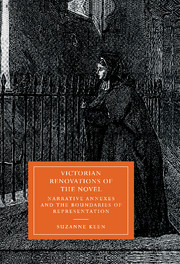Book contents
- Frontmatter
- Contents
- Acknowledgments
- 1 Narrative annexes: altered spaces, altered modes
- 2 Victorian critics, narrative annexes, and prescriptions for the novel
- 3 Norms and narrow spaces: the gendering of limits on representation
- 4 Narrative annexes, social mobility, and class anxiety
- 5 Older, deeper, further: narrative annexes and the extent of the Condition of England
- 6 Victorian annexes and modern form
- Notes
- Bibliography
- Index
- CAMBRIDGE STUDIES IN NINETEENTH-CENTURY LITERATURE AND CULTURE
4 - Narrative annexes, social mobility, and class anxiety
Published online by Cambridge University Press: 13 November 2009
- Frontmatter
- Contents
- Acknowledgments
- 1 Narrative annexes: altered spaces, altered modes
- 2 Victorian critics, narrative annexes, and prescriptions for the novel
- 3 Norms and narrow spaces: the gendering of limits on representation
- 4 Narrative annexes, social mobility, and class anxiety
- 5 Older, deeper, further: narrative annexes and the extent of the Condition of England
- 6 Victorian annexes and modern form
- Notes
- Bibliography
- Index
- CAMBRIDGE STUDIES IN NINETEENTH-CENTURY LITERATURE AND CULTURE
Summary
SOCIAL FICTION AND THE BOUNDARIES OF REPRESENTATION
Any account of the social restrictions on representation in the Victorian novel would be incomplete without acknowledging the importance of the mythical figure Mrs. Grundy. Her person represents most plainly the gendered limits on representation, for it is she, on behalf of novel-reading young ladies, who forbids frank depiction of adult sexuality. If, as we have seen, some prominent Victorian critics held women writers and female readers to blame for a constricted realm of representation (even as they enforced those limits when responding to novels by women), to these same critics Mrs. Grundy embodied the worst of a “maternal” impulse to protect the vulnerable young person from the effects of fiction-reading. Her genesis can be traced to the early nineteenth- century evangelical reaction to the dangers of novels, promulgated in warnings such as this one from an 1824 issue of the Lady's Magazine:
One great foremost evil of novel-reading is generated and established in its tendency to banish simplicity and nature from the mind, and to form artificial, imitative character; to fashion and confirm a practised mind; to seduce the frank and honest disposition from its native ingenuousness, and to teach the art of acting perpetually upon plan; to be frivolously busy in analysing what never can be analysed, except by that power which formed it – the human heart.
Novel-reading leads to a fondness of making experiments on the affections of others toward ourselves.
In fighting a losing battle against the reading of fiction, particularly by girls and young unmarried ladies, the evangelical proscribers in subsequent decades target, instead of all novels, particular areas of representation of human life.
- Type
- Chapter
- Information
- Victorian Renovations of the NovelNarrative Annexes and the Boundaries of Representation, pp. 111 - 144Publisher: Cambridge University PressPrint publication year: 1997



